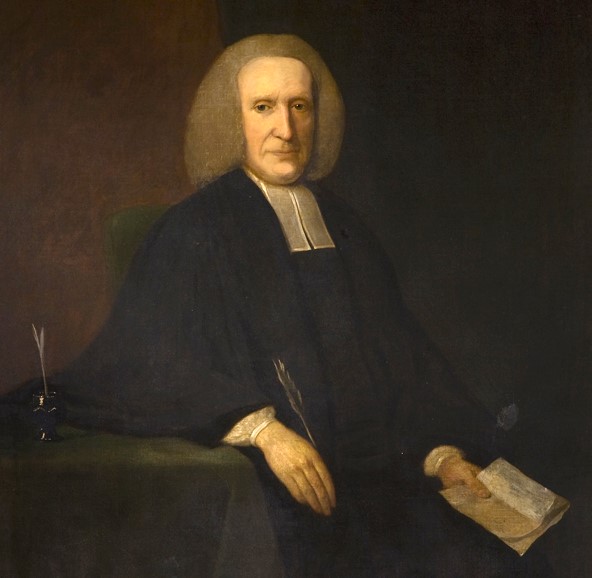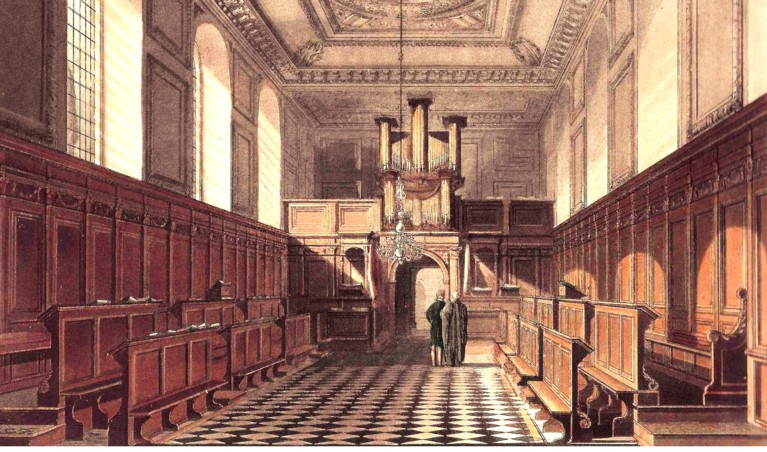Blog
6 September 2023

Dr William Richardson
Almost every biographical account of Dr William Richardson, Master of Emmanuel 1735-1775, states that he and his wife, Ann, are buried in the college chapel. This information derives ultimately from Nichols’s Literary Anecdotes. The earliest edition of this work, published in 1782, states: ‘[Richardson] died March 14, 1775, and was buried in the same vault with his wife, under the litany desk in the chapel of his College’.
The principal authors of Literary Anecdotes were William Bowyer (died 1777) and his assistant, and later successor, John Nichols. As Bowyer had been up at Cambridge at the same time as Richardson, and was a fellow member of the Royal Society of Antiquaries, he ought to be a reliable source. Yet there is nothing in the college archives, such as payments to grave-diggers, to corroborate the burial of either Richardson or his wife in Emmanuel’s chapel.
Another source of doubt is the absence of any memorial to Richardson, who had been Master, albeit an unpopular one, for 39 years. If there ever was an engraved stone it soon disappeared, for the Richardsons are not mentioned in Cooper’s Memorials of Cambridge (published 1861), which listed all the monumental inscriptions at Emmanuel. During the chapel’s restoration works of 2003-4, a brick-lined burial vault was discovered abutting the east wall, but it appeared to contain only one (collapsed) coffin. It is almost certainly the tomb of John Breton, Master 1665-1676, whose corpse, we know, was transferred in 1677 from the old chapel to the new.
Despite the lack of documentation, the fact that Literary Anecdotes was published so soon after Richardson’s death, means that its statement about the Master’s burial has to be taken seriously. It was hoped that an inspection of the church registers of St Andrew the Great (within which parish Emmanuel is sited) would settle the matter. The most accessible version of the relevant register is to be found in the Bishop’s Transcripts, the copies of of register entries sent annually by parish priests to their bishop. The BTs for St Andrew, which are held among the Diocese of Ely archives in Cambridge University Library, record the burials of Ann Richardson (27 March 1759), and her husband (19 March 1775), but neither entry states whether the interment was at Emmanuel, or the parish church.
As every genealogist knows, however, BTs tend to cut a few corners, as the annual task of transcription was widely regarded as a tedious chore. It was therefore necessary to consult the original register, too, held at Cambridgeshire Archives. Finally, the matter was settled, at least in respect of Dr Richardson, for the register states categorically that he was ‘buried at Eman Coll’. It is silent, however, about the location of his wife’s interment. If Ann is indeed buried in our chapel, she is the only Emmanuel Master’s wife ever to be thus honoured. Any resistance from the Fellowship would doubtless have been overcome by Dr Richardson’s forceful personality.

Emmanuel Chapel, 1814. Do the Richardsons lie beneath the marble tiles?
During the 2003-4 chapel restoration works, most of the marble floor tiles were lifted, without revealing any grave other than Breton’s, but a deeper exploration would no doubt expose the Richardson vault. Such a procedure is of course out of the question, at least for such a purpose, but if it ever becomes necessary to excavate the floor, it is likely that other unmarked graves will also be found. According to the St Andrew parish registers, three more Emmanuel men, for whom there are no surviving monumental inscriptions, are buried in the chapel: Jarvis Needham, William Carrington and Theophilus Davis, all of whom died in the first decade of the eighteenth century.
Amanda Goode, College Archivist